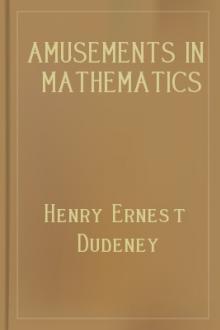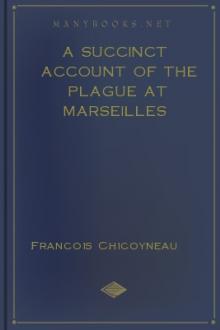Amusements in Mathematics, Henry Ernest Dudeney [books to read to be successful txt] 📗

- Author: Henry Ernest Dudeney
- Performer: 0486204731
Book online «Amusements in Mathematics, Henry Ernest Dudeney [books to read to be successful txt] 📗». Author Henry Ernest Dudeney

The first player must place his first cigar on end in the exact centre of the table, as indicated by the little circle. Now, whatever the second player may do throughout, the first player must always repeat it in an exactly diametrically opposite position. Thus, if the second player places a cigar at A, I put one at AA; he places one at B, I put one at BB; he places one at C, I put one at CC; he places one at D, I put one at DD; he places one at E, I put one at EE; and so on until no more cigars can be placed without touching. As the cigars are supposed to be exactly alike in every respect, it is perfectly clear that for every move that the second player may choose to make, it is possible exactly to repeat it on a line drawn through the centre of the table. The second player can always duplicate the first player's move, no matter where he may place a cigar, or whether he places it on end or on its side. As the cigars are all alike in every respect, one will obviously balance over the edge of the table at precisely the same point as another. Of course, as each player is supposed to play in the best possible manner, it becomes a matter of theory. It is no valid objection to say that in actual practice one would not be sufficiently exact to be sure of winning. If as the first player you did not win, it would be in consequence of your not having played the best possible.
The second diagram will serve to show why the first cigar must be placed on end. (And here I will say that the first cigar that I selected from a box I was able so to stand on end, and I am allowed to assume that all the other cigars would do the same.) If the first cigar were placed on its side, as at F, then the second player could place a cigar as at G—as near as possible, but not actually touching F. Now, in this position you cannot repeat his play on the opposite side, because the two ends of the cigar are not alike. It will be seen that GG, when placed on the opposite side in the same relation to the centre, intersects, or lies on top of, F, whereas the cigars are not allowed to touch. You must therefore put the cigar farther away from the centre, which would result in your having insufficient room between the centre and the bottom left-hand corner to repeat everything that the other player would do between G and the top right-hand corner. Therefore the result would not be a certain win for the first player.
399.—THE TROUBLESOME EIGHT.—solution

The conditions were to place a different number in each of the nine cells so that the three rows, three columns, and two diagonals should each add up 15. Probably the reader at first set himself an impossible task through reading into these conditions something which is not there—a common error in puzzle-solving. If I had said "a different figure," instead of "a different number," it would have been quite impossible with the 8 placed anywhere but in a corner. And it would have been equally impossible if I had said "a different whole number." But a number may, of course, be fractional, and therein lies the secret of the puzzle. The arrangement shown in the figure will be found to comply exactly with the conditions: all the numbers are different, and the square adds up 15 in all the required eight ways.
400.—THE MAGIC STRIPS.—solution
There are of course six different places between the seven figures in which a cut may be made, and the secret lies in keeping one strip intact and cutting each of the other six in a different place. After the cuts have been made there are a large number of ways in which the thirteen pieces may be placed together so as to form a magic square. Here is one of them:—

The arrangement has some rather interesting features. It will be seen that the uncut strip is at the top, but it will be found that if the bottom row of figures be placed at the top the numbers will still form a magic square, and that every successive removal from the bottom to the top (carrying the uncut strip stage by stage to the bottom) will produce the same result. If we imagine the numbers to be on seven complete perpendicular strips, it will be found that these columns could also be moved in succession from left to right or from right to left, each time producing a magic square.
401.—EIGHT JOLLY GAOL BIRDS.—solution
There are eight ways of forming the magic square—all merely different aspects of one fundamental arrangement. Thus, if you give our first square a quarter turn you will get the second square; and as the four sides may be in turn brought to the top, there are four aspects. These four in turn reflected in a mirror produce the remaining four aspects. Now, of these eight arrangements only four can possibly be reached under the conditions, and only two of these four can be reached in the fewest possible moves, which is nineteen. These two arrangements are shown. Move the men in the following order: 5, 3, 2, 5, 7, 6, 4, 1, 5, 7, 6, 4, 1, 6, 4, 8, 3, 2, 7, and you get the first square. Move them thus: 4, 1, 2, 4, 1, 6, 7, 1, 5, 8, 1, 5, 6, 7, 5, 6, 4, 2, 7, and you have the arrangement in the second square. In the first case every man has moved, but in the second case the man numbered 3 has never left his cell. Therefore No. 3 must be the obstinate prisoner, and the second square must be the required arrangement.

402.—NINE JOLLY GAOL BIRDS.—solution
There is a pitfall set for the unwary in this little puzzle. At the start one man is allowed to be placed on the shoulders of another, so as to give always one empty cell to enable the prisoners to move about without any two ever being in a cell together. The two united prisoners are allowed to add their numbers together, and are, of course, permitted to remain together at the completion of the magic square. But they are obviously not compelled so to remain together, provided that one of the pair on his final move does not break the condition of entering a cell already occupied. After the acute solver has noticed this point, it is for him to determine which method is the better one—for the two to be together at the count or to separate. As a matter of fact, the puzzle can be solved in seventeen moves if the men are to remain together; but if they separate at the end, they may actually save a move and perform the feat in sixteen! The trick consists in placing the man in the centre on the back of one of the corner men, and then working the pair into the centre before their final separation.

Here are the moves for getting the men into one or other of the above two positions. The numbers are those of the men in the order in which they move into the cell that is for the time being vacant. The pair is shown in brackets:—
Place 5 on 1. Then, 6, 9, 8, 6, 4, (6), 2, 4, 9, 3, 4, 9, (6), 7, 6, 1.
Place 5 on 9. Then, 4, 1, 2, 4, 6, (14), 8, 6, 1, 7, 6, 1, (14), 3, 4, 9.
Place 5 on 3. Then, 6, (8), 2, 6, 4, 7, 8, 4, 7, 1, 6, 7, (8), 9, 4, 3.
Place 5 on 7. Then, 4, (12), 8, 4, 6, 3, 2, 6, 3, 9, 4, 3, (12), 1, 6, 7.
The first and second solutions produce Diagram A; the second and third produce Diagram B. There are only sixteen moves in every case. Having found the fewest moves, we had to consider how we were to make the burdened man do as little work as possible. It will at once be seen that as the pair have to go into the centre before separating they must take at fewest two moves. The labour of the burdened man can only be reduced by adopting the other method of solution, which, however, forces us to take another move.
403.—THE SPANISH DUNGEON.—solution

This can best be solved by working backwards—that is to say, you must first catch your square, and then work back to the original position. We must first construct those squares which are found to require the least amount of readjustment of the numbers. Many of these we know cannot possibly be reached. When we have before us the most favourable possible arrangements, it then becomes a question of careful analysis to discover which position can be reached in the fewest moves. I am afraid, however, it is only after considerable study and experience that the solver is able to get such a grasp of the various "areas of disturbance" and methods of circulation that his judgment is of much value to him.
The second diagram is a most favourable magic square position. It will be seen that prisoners 4, 8, 13, and 14 are left in their original cells. This position may be reached in as few as thirty-seven moves. Here are the moves: 15, 14, 10, 6, 7, 3, 2, 7, 6, 11, 3, 2, 7, 6, 11, 10, 14, 3, 2, 11, 10, 9, 5, 1, 6, 10, 9, 5, 1, 6, 10, 9, 5, 2, 12, 15, 3. This short solution will probably surprise many readers who may not find a way under from sixty to a hundred moves. The clever prisoner was No. 6, who in the original illustration will be seen with his arms extended calling out the moves. He and No. 10 did most of the work, each changing his cell five times. No. 12, the man with the crooked leg, was lame, and therefore fortunately had only to pass from his cell into the next one when his time came round.
404.—THE SIBERIAN DUNGEONS.—solution

In attempting to solve this puzzle it is clearly necessary to seek such magic squares as seem the most favourable for our purpose, and then carefully examine and try them for "fewest moves." Of course it at once occurs to us that if we can adopt a square in which a certain number of men need not leave their original cells, we may save moves on the one hand, but we may obstruct our movements on the other. For example, a magic square may be formed with the 6, 7, 13, and 16 unmoved; but in such case it is obvious that a solution is impossible, since cells 14 and 15 can neither be left nor entered without breaking the condition of no two men ever being in the same cell together.
The following solution in fourteen moves was found by Mr. G. Wotherspoon: 8-17, 16-21, 6-16, 14-8, 5-18, 4-14, 3-24, 11-20, 10-19, 2-23, 13-22, 12-6, 1-5, 9-13. As this solution is in what I consider the theoretical





Comments (0)